Unpacking and publishing the Phaistos Disk since 1993
HOME | PREVIOUS | NEXT | SITEMAP
Page 3 - DREAM PERSPECTIVE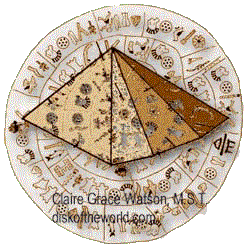
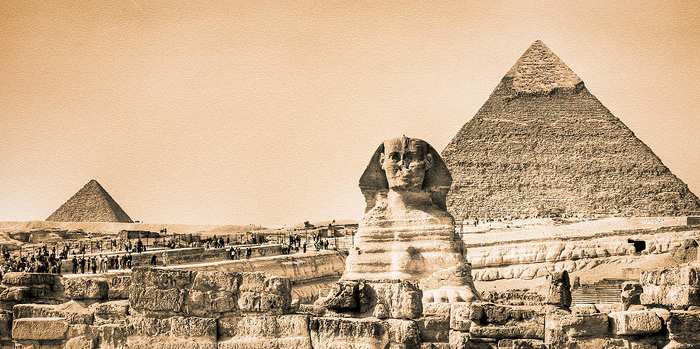
Phaistos Disk pyramid compared with pyramids of Giza
To find my solution to this puzzle, you need to gain a new perspective, and that's one thing the dreams did for me. Try this. Pretend the Phaistos Disk (below right, traced and colorized) is a miniature of your consciousness. The top disk is the conscious mind and the bottom is the unconscious mind. At casual glance they appear to be identical, containing individual thoughts/pictographs. You can see the minds are separate, so you wonder if the thoughts are connected. You try a simple connect-the-dots method to connect the matching thoughts, and this reveals ideas. Now that you have revealed the ideas, you wonder how to connect the conscious mind with the unconscious mind, but to discover that you have to solve the maze and reveal the secret bridge. Then you can see how infinite is consciousness.
"I just wanted to tell you that I am very impressed by the astronomical and mathematical patterns you found on the Disk. I feel that the patterns you found are too many and too accurate to be mere coincidence, and joining the matching symbols is such a simple and elegant solution! I am very surprised that no-one else has noticed these patterns before!" (Rhona Bloxsom, Reading, England)

![]()
![]() After spending days trying to read the pictographs like hieroglyphs, I awoke one morning, looked at the disk, and thought I recognized a pattern made by the six carpenter's squares (left) on one side of the disk. The carpenter's square looks like a pyramid, and how else could you build one of the seven wonders of the world without one of these? On the disk it appears sideways, as an arrow pointing and implying movement. When I connected them with lines, a pyramid appeared, drawn as in geometry to indicate four sides. Once invisible on the disk, it now stood above it, the spiral behind it making it 3D. I thought it was the Great Pyramid because of my dreams and because of the pyramid's proximity to Crete, where the disk was discovered. This was the first of five major hidden pictographs I was to excavate as an archaeoastronomer, and many lesser ones to follow.
After spending days trying to read the pictographs like hieroglyphs, I awoke one morning, looked at the disk, and thought I recognized a pattern made by the six carpenter's squares (left) on one side of the disk. The carpenter's square looks like a pyramid, and how else could you build one of the seven wonders of the world without one of these? On the disk it appears sideways, as an arrow pointing and implying movement. When I connected them with lines, a pyramid appeared, drawn as in geometry to indicate four sides. Once invisible on the disk, it now stood above it, the spiral behind it making it 3D. I thought it was the Great Pyramid because of my dreams and because of the pyramid's proximity to Crete, where the disk was discovered. This was the first of five major hidden pictographs I was to excavate as an archaeoastronomer, and many lesser ones to follow.
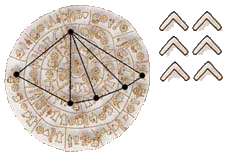
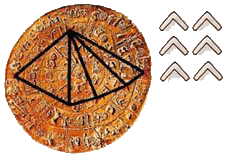

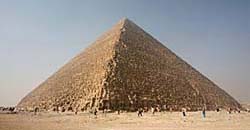
Excavate the Great Pyramid by connecting the six matching Pyramid/Carpenter's Square signs on side one. This new pyramid is a larger, hidden pictograph on the disk, perhaps meaning Great Pyramid. Combined with the carpenter's squares, I suggest this meaning:
Could there be a connection between the ziggurats and the pyramid? Could it be the pyramid was also prepared as the "house of the god?" Do two such pictographs indicate two pyramids on the Phaistos Disk? I began to "dig" for the second pyramid on the disk, but because it was an interior view I had a wrong idea of how it would look, so I didn't excavate it for many years.
My quest for lost knowledge and a desire to solve this mystery set me on a course to find the other pyramid and any other concealed pictographs. I didn't know it would take twenty years, so that's sixty bridge nationals I missed. Oh well, I wouldn't have gone to most of them, anyway.
I found most of the patterns within a few months, but it was always the thrill of finding something new, the "ah ha!" moments, and the research that I loved so much, the learning about that period of time and that little island civilization. I just fell in love with it and merged with it, became immersed in their world and their art. I went back in time to that place. I went via my research and also my dreams. The place exists in my mind and I feel I am a part of it. Working on the disk and learning about it, discovering its secrets, makes me truly happy.
Claire's own site, Disk of the World, is a beauty and a wonder. (Arsen Darney, Ghulf Genes)
![]()
![]()
![]()
![]()
![]()
![]()
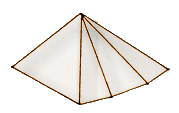
 Not aliens :) I wondered what other pictographs might be concealed on the disk, so I made exact tracings of the both sides of the disk to see the effect of the spiral behind the other hidden images. No one had ever done this before. They might have gone to the trouble if they had known Houghton-Mifflin publishing company would pay them $800 to put one of the tracings on the cover of one of their college English composition textbooks entitled Making Sense. (left)
Not aliens :) I wondered what other pictographs might be concealed on the disk, so I made exact tracings of the both sides of the disk to see the effect of the spiral behind the other hidden images. No one had ever done this before. They might have gone to the trouble if they had known Houghton-Mifflin publishing company would pay them $800 to put one of the tracings on the cover of one of their college English composition textbooks entitled Making Sense. (left)
![]()
![]()
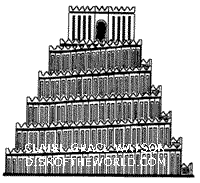 This odd pictograph appears twice on the disk and I wondered if it might have something to do with the Great Pyramid. I had read somewhere, in one of those many books, that In ancient Mesopotamia the top of the ziggurats were marked with a pictograph identical to the letter E. It meant "house of the god." A place was created there for the god on earth, who was thought to descend to take up residence in the house prepared for it.
This odd pictograph appears twice on the disk and I wondered if it might have something to do with the Great Pyramid. I had read somewhere, in one of those many books, that In ancient Mesopotamia the top of the ziggurats were marked with a pictograph identical to the letter E. It meant "house of the god." A place was created there for the god on earth, who was thought to descend to take up residence in the house prepared for it.